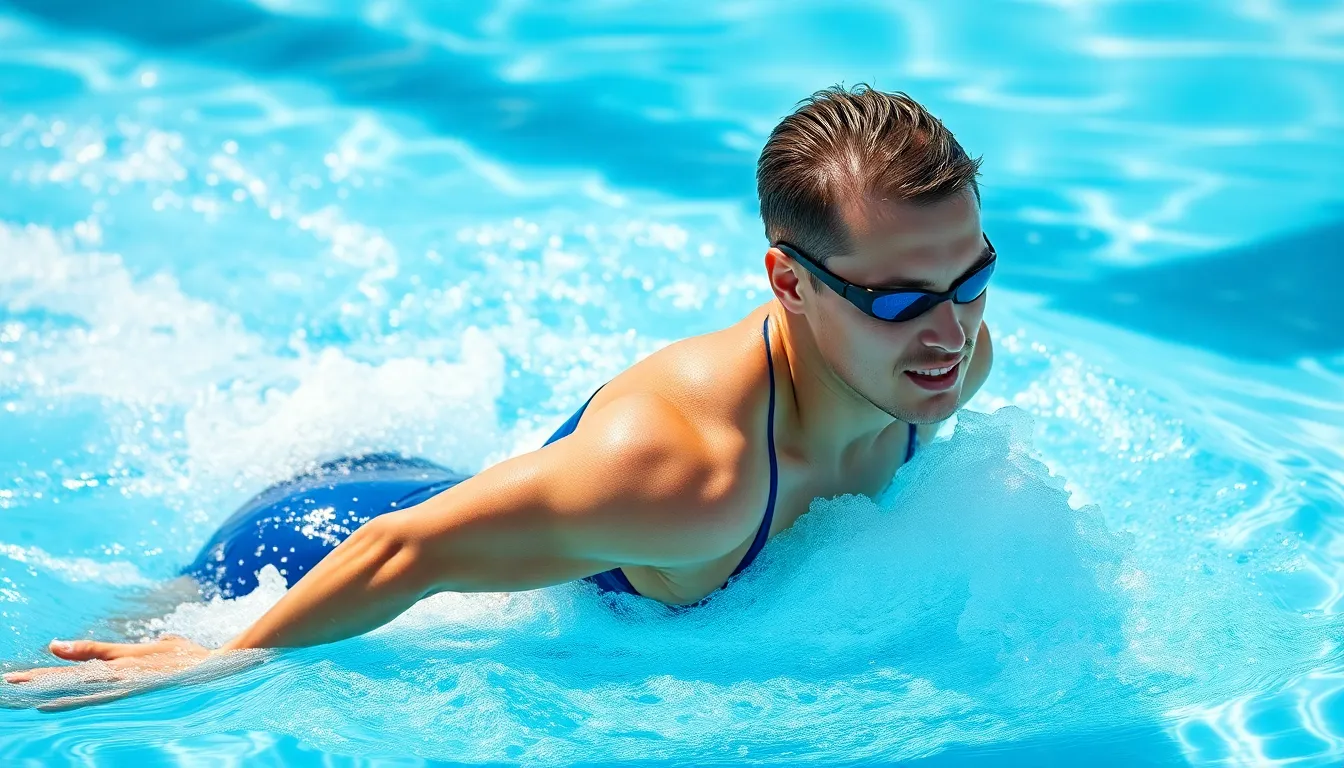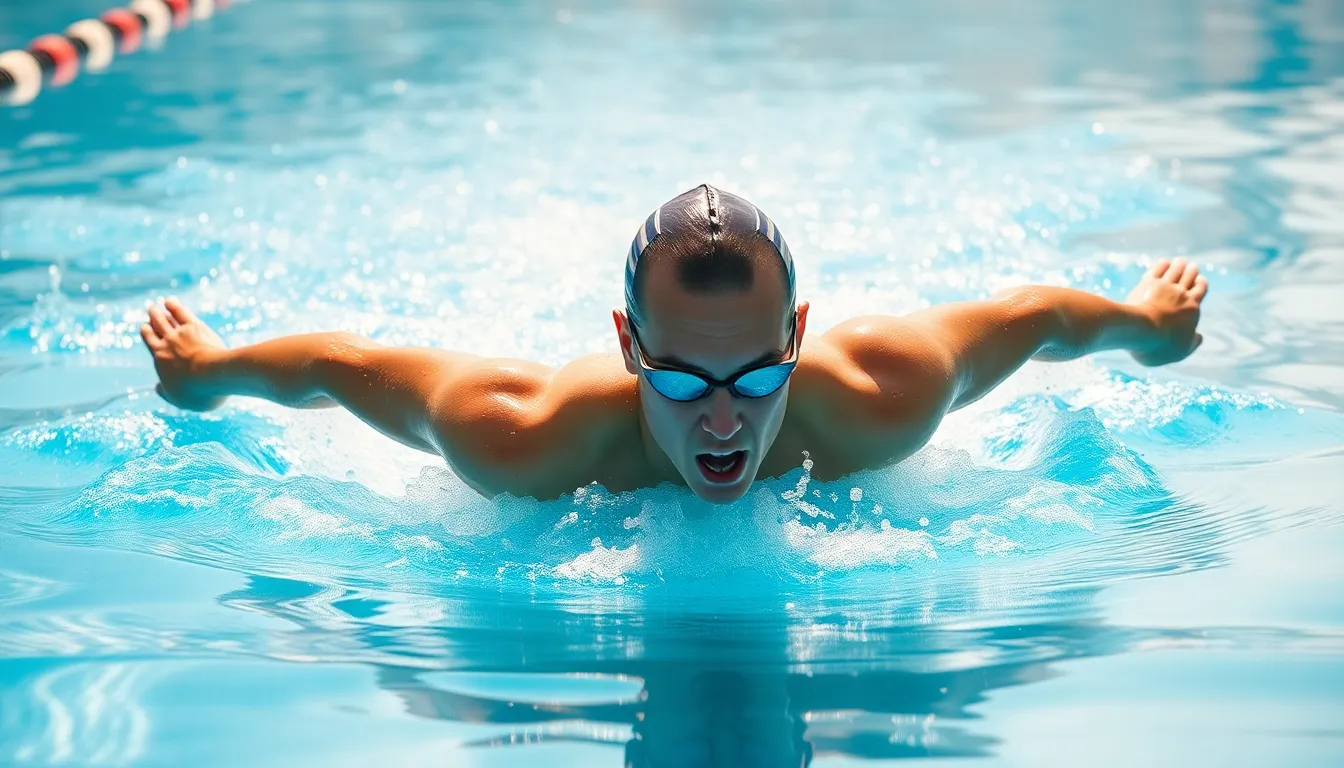Table of Contents
ToggleLap swimming offers a unique blend of fitness, relaxation, and skill development, making it a favorite among water enthusiasts. Whether you’re a seasoned swimmer or just starting, gliding through the water provides an excellent full-body workout while promoting cardiovascular health. The rhythmic strokes and soothing nature of the water can also help clear the mind, creating a perfect escape from daily stresses.
As more people discover the benefits of lap swimming, pools around the world become bustling hubs of activity. From improving endurance to enhancing technique, lap swimming caters to various fitness goals. With its low-impact nature, it’s an ideal choice for individuals of all ages looking to stay active. Dive into the world of lap swimming and explore how it can transform your fitness routine and overall well-being.
What Is Lap Swimming?
Lap swimming consists of swimming back and forth in a designated lane at a pool, focusing on consistent pacing. This activity involves various strokes, including freestyle, breaststroke, backstroke, and butterfly. It serves multiple purposes, including fitness, relaxation, and skill enhancement. People participate in lap swimming to build endurance, improve technique, and engage in an effective cardiovascular workout.
Lap swimming provides a structured environment, allowing swimmers to set goals and track progress over time. Swimmers can adjust their routines based on experience levels, making it suitable for beginners and experienced swimmers alike. Many facilities offer lap swimming times during designated hours, ensuring a quiet and focused atmosphere. In addition to physical benefits, lap swimming promotes mental clarity and stress relief through rhythmic movements and water immersion.
Benefits Of Lap Swimming

Lap swimming offers numerous advantages for both physical and mental health, making it an effective component of a well-rounded fitness regimen.
Physical Health Benefits
Lap swimming delivers a comprehensive workout targeting multiple muscle groups. It improves cardiovascular fitness by raising heart rate and enhancing blood circulation. It also increases muscular strength and endurance through resistance provided by water. Swimming engages core muscles, enhancing stability and posture. Additionally, lap swimming is low-impact, reducing strain on joints, which makes it an excellent exercise for various age groups and fitness levels.
| Benefit | Description |
|---|---|
| Cardiovascular Fitness | Improves heart health, increases lung capacity, boosts endurance. |
| Muscle Strength | Engages various muscle groups, builds overall strength. |
| Joint Safety | Offers a low-impact workout, minimizes risk of injuries. |
| Core Stability | Enhances balance and posture through consistent engagement of core. |
Mental Health Benefits
Lap swimming serves as a powerful tool for stress relief and mental clarity. The repetitive nature of swimming induces a meditative state, promoting relaxation and reducing anxiety levels. Water immersion has calming effects that can alleviate symptoms of depression and improve overall mood. Establishing a routine in lap swimming can foster a sense of accomplishment, contributing positively to self-esteem and mental resilience.
Tips For Effective Lap Swimming
Effective lap swimming requires attention to technique and goal-setting to maximize benefits.
Proper Technique
Proper technique enhances efficiency and reduces the risk of injury. Swimmers should:
- Maintain a streamlined position by keeping the body horizontal in the water. This minimizes drag and allows smoother movement through the water.
- Breathe rhythmically to maintain proper pacing. Inhale during arm recovery and exhale underwater.
- Utilize correct stroke mechanics for each stroke type. For example, during freestyle, focus on high elbows and an elongated reach.
- Kick effectively by using a flutter kick for freestyle or a frog kick for breaststroke, ensuring the legs remain straight and generate propulsion without excessive splashing.
- Balance the strokes through coordinated arm and leg movements to promote effective energy distribution throughout each lap.
Setting Goals
- Determine specific targets, such as distance, time, or technique-related goals like improving stroke efficiency.
- Establish measurable benchmarks to assess performance after each swim session. For example, track lap times using a stopwatch.
- Create a training schedule that incorporates varied swim workouts, allowing for skill development and endurance building.
- Set long-term and short-term objectives to maintain focus and motivation. Short-term goals could include improving lap time within a month, while long-term goals might cover preparing for competitive events.
- Regularly reassess goals to ensure they remain relevant and challenging, adapting to growth and changing skill levels.
Common Mistakes To Avoid
Lap swimming can enhance overall fitness, but swimmers often commit mistakes that hinder progress and increase the risk of injury. Recognizing and avoiding these errors is essential for maximizing the benefits of swimming.
- Neglecting Warm-Up and Cool Down
Ignoring warm-up and cool-down routines can lead to muscle strain. Implement a 5-10 minute warm-up, such as gentle stretching or easy swimming, to prepare the body for exertion. Following the session, cooldown with lighter strokes to aid recovery.
- Poor Stroke Technique
Using incorrect stroke mechanics can cause inefficient swimming and fatigue. Focus on maintaining proper body alignment, hand entry, and kick technique. Regularly seek feedback from coaches or experienced swimmers to refine skills.
- Inconsistent Breathing Patterns
Inconsistency in breathing may disrupt rhythm and efficiency. Practice breathing at regular intervals, ensuring oxygen intake does not compromise stroke form. Experiment with breathing on both sides to enhance comfort and balance.
- Overexerting Yourself
Pushing too hard during workouts can lead to burnout and injuries. Start with manageable distances and gradually increase intensity. Listen to the body and include rest days to facilitate recovery.
- Skipping Hydration
Failing to hydrate adequately can impair performance. Drink water before, during, and after lap swimming sessions to maintain optimal hydration levels.
- Disregarding Lane Etiquette
Ignoring lane rules disrupts the flow and can lead to collisions. Be mindful of the posted regulations, swim within designated lanes, and signal intentions to others when passing.
- Using Inappropriate Gear
Employing ill-fitting or inappropriate swim gear can hinder performance and comfort. Invest in a well-fitted swimsuit, goggles, and swim cap to enhance confidence and efficiency in the water.
- Lack of Goal Setting
Not having clear objectives can result in aimless swimming. Establish specific, measurable goals related to speed, distance, or technique to track progress and maintain motivation.
Avoiding these common mistakes allows swimmers to enhance their lap swimming experience, ensuring effective workouts while minimizing the risk of injury.
Gear And Equipment For Lap Swimming
Selecting appropriate gear and equipment enhances the lap swimming experience. Key items include:
- Swimsuit: A well-fitted, streamlined swimsuit reduces drag in the water, enabling smoother movement. Swimmers should choose suits designed for performance, such as those made from nylon or spandex.
- Goggles: Quality goggles provide clear visibility and protect the eyes from chlorine. Swimmers should select goggles that fit snugly and prevent leaks while ensuring comfort during extended use.
- Swim Cap: A swim cap keeps hair out of the face and reduces drag. It’s advisable to select a cap made from silicone or latex for durability and comfort.
- Kickboard: A kickboard aids in developing leg strength and improving kicking technique. Swimmers can use it to isolate the legs during practice sessions.
- Pull Buoy: A pull buoy enhances upper body strength by floating the legs, allowing swimmers to focus on stroke mechanics without kicking. Proper use promotes better stroke efficiency.
- Fins: Fins increase propulsion and improve kick technique. Swimmers should choose fins that are comfortable and appropriate for their swimming level.
- Paddles: Hand paddles can help build upper body strength and improve stroke technique. Swimmers should select paddles that fit comfortably over the hands, allowing for natural movement.
- Water Bottle: Staying hydrated is crucial. A water bottle should accompany swimmers to ensure adequate fluid intake before and after practice.
Each of these items supports specific training aspects and contributes to effective lap swimming. Swimmers must consider personal preferences and comfort when choosing gear, as these factors enhance performance and enjoyment in the water.
Lap swimming stands out as an exceptional way to blend fitness with relaxation. Its versatility allows individuals of all ages to enjoy the physical and mental benefits it offers. By incorporating proper techniques and setting achievable goals, swimmers can enhance their skills while enjoying the calming effects of water.
With the right gear and a structured approach, lap swimming becomes not just a workout but a fulfilling experience. As more people discover its advantages, it’s clear that lap swimming is a valuable addition to any fitness routine. Embracing this activity can lead to improved health and well-being, making it a worthwhile pursuit for anyone looking to stay active and centered.




